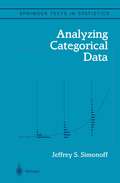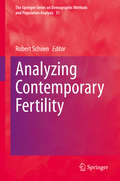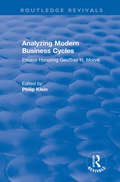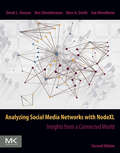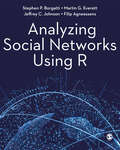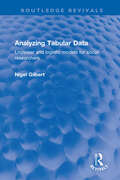- Table View
- List View
Analyzing Affective Societies: Methods and Methodologies (Routledge Studies in Affective Societies)
by Antje KahlIn recent years, research in the social sciences and cultural studies has increasingly paid attention to the generative power of emotions and affects; that is, to the questions of how far they shape social and cultural processes while being simultaneously shaped by them. However, the literature on the methodological implications of researching affects and emotions remains rather limited. As a collective outcome of the Collaborative Research Center (CRC) Affective Societies at Freie Universität Berlin, Analyzing Affective Societies introduces procedures and methodologies applied by researchers of the CRC for investigating societies as affective societies. Presenting scholarly research practices by means of concrete examples and case studies, the book does not contain any conclusive methodological advice, but rather engages in illustrative descriptions of the authors’ research practices. Analyzing Affective Societies unveils different research approaches, procedures and practices of a variety of disciplines from the humanities, arts and social sciences. It will appeal to students and researchers interested in fields such as Qualitative Research Methods, Emotions, Affect, Cultural Studies and Social Sciences.
Analyzing Affective Societies: Methods and Methodologies (Routledge Studies in Affective Societies)
by Antje KahlIn recent years, research in the social sciences and cultural studies has increasingly paid attention to the generative power of emotions and affects; that is, to the questions of how far they shape social and cultural processes while being simultaneously shaped by them. However, the literature on the methodological implications of researching affects and emotions remains rather limited. As a collective outcome of the Collaborative Research Center (CRC) Affective Societies at Freie Universität Berlin, Analyzing Affective Societies introduces procedures and methodologies applied by researchers of the CRC for investigating societies as affective societies. Presenting scholarly research practices by means of concrete examples and case studies, the book does not contain any conclusive methodological advice, but rather engages in illustrative descriptions of the authors’ research practices. Analyzing Affective Societies unveils different research approaches, procedures and practices of a variety of disciplines from the humanities, arts and social sciences. It will appeal to students and researchers interested in fields such as Qualitative Research Methods, Emotions, Affect, Cultural Studies and Social Sciences.
Analyzing and Theorizing the Dynamics of the Workplace Incivility Crisis (SpringerBriefs in Psychology #8)
by Michael LeiterContemporary worklife builds upon a foundation for teamwork among skilled and dedicated people. Despite the utility of supportive working relationships and despite extensive consulting activity on leadership and team building, employees complain extensively about mistreatment by their bosses and colleagues. Analyzing and Theorizing the Dynamics of the Workplace Incivility Crisis presents a theoretic framework for considering the fundamental issues of group dynamics and individual psychology that lie behind this ongoing workplace incivility crisis. It contextualizes the need for belonging as a motivation that shapes expressed social behaviour and intensifies received social behaviour. Looking at cognitive elements as well as rudeness rationales that pertain to workplace incivility and its justification, this work maps social constructs, including the role of team leadership, that lead to setting implicit social norms. In addition to formulating a theoretical framework, Analyzing and Theorizing the Dynamics of the Workplace Incivility Crisis considers methods to address the dynamics that perpetuate incivility at work and actively points at setting an action agenda to evaluate their impact.
Analyzing Categorical Data (Springer Texts in Statistics)
by Jeffrey S. SimonoffCategorical data arise often in many fields, including biometrics, economics, management, manufacturing, marketing, psychology, and sociology. This book provides an introduction to the analysis of such data. The coverage is broad, using the loglinear Poisson regression model and logistic binomial regression models as the primary engines for methodology. Topics covered include count regression models, such as Poisson, negative binomial, zero-inflated, and zero-truncated models; loglinear models for two-dimensional and multidimensional contingency tables, including for square tables and tables with ordered categories; and regression models for two-category (binary) and multiple-category target variables, such as logistic and proportional odds models. All methods are illustrated with analyses of real data examples, many from recent subject area journal articles. These analyses are highlighted in the text, and are more detailed than is typical, providing discussion of the context and background of the problem, model checking, and scientific implications. More than 200 exercises are provided, many also based on recent subject area literature. Data sets and computer code are available at a web site devoted to the text. Adopters of this book may request a solutions manual from: textbook@springer-ny.com. From the reviews: "Jeff Simonoff's book is at the top of the heap of categorical data analysis textbooks...The examples are superb. Student reactions in a class I taught from this text were uniformly positive, particularly because of the examples and exercises. Additional materials related to the book, particularly code for S-Plus, SAS, and R, useful for analysis of examples, can be found at the author's Web site at New York University. I liked this book for this reason, and recommend it to you for pedagogical purposes." (Stanley Wasserman, The American Statistician, August 2006, Vol. 60, No. 3) "The book has various noteworthy features. The examples used are from a variety of topics, including medicine, economics, sports, mining, weather, as well as social aspects like needle-exchange programs. The examples motivate the theory and also illustrate nuances of data analytical procedures. The book also incorporates several newer methods for analyzing categorical data, including zero-inflated Poisson models, robust analysis of binomial and poisson models, sandwich estimators, multinomial smoothing, ordinal agreement tables…this is definitely a good reference book for any researcher working with categorical data." Technometrics, May 2004 "This guide provides a practical approach to the appropriate analysis of categorical data and would be a suitable purchase for individuals with varying levels of statistical understanding." Paediatric and Perinatal Epidemiology, 2004, 18 "This book gives a fresh approach to the topic of categorical data analysis. The presentation of the statistical methods exploits the connection to regression modeling with a focus on practical features rather than formal theory...There is much to learn from this book. Aside from the ordinary materials such as association diagrams, Mantel-Haenszel estimators, or overdispersion, the reader will also find some less-often presented but interesting and stimulating topics...[T]his is an excellent book, giving an up-to-date introduction to the wide field of analyzing categorical data." Biometrics, September 2004 "...It is of great help to data analysts, practitioners and researchers who deal with categorical data and need to get a necessary insight into the methods of analysis as well as practical guidelines for solving problems." International Journal of General Systems, August 2004 "The author has succeeded in writing a useful and readable textbook combining most of general theory and practice of count data." Kwantitatieve Methoden "The book especially stresses how to analyze and interpret data...In fact, the highly detailed mult
Analyzing Contemporary Fertility (The Springer Series on Demographic Methods and Population Analysis #51)
by Robert SchoenThis edited volume offers state-of-the-art research on the dynamics of contemporary fertility by examining the implications of the economic and social forces that are driving the rapid change in fertility behavior, and the changing context, determinants, and measurement of contemporary human reproduction. The volume explores new theoretical avenues that seek to incorporate uncertainty, examine social contagion effects, and explain the rise in childlessness. Reproductive attitudes are re-examined in chapters that deal with models of parenthood and with the persistence of race-ethnic-nativity differences. A new and important subject of multi-partner fertility is also described by examining it in the context of total fertility and from the usually neglected perspective of men. The impact of divorce on fertility, the measurement of childlessness and the postponement of first births, developments in assortative mating and fertility, and current patterns of interracial fertility are also addressed in this volume. By combining up-to-date research spanning the entire field to illuminate contemporary developments, the book is a valuable source for demographers, sociologists, economists, and all those interested in understanding fertility in today's world.
Analyzing Digital Discourse: New Insights and Future Directions
by Pilar Garcés-Conejos Blitvich Patricia Bou-FranchThis innovative edited collection presents new insights into emerging debates around digital communication practices. It brings together research by leading international experts to examine methods and approaches, multimodality, face and identity, across five thematically organised sections. Its contributors revise current paradigms in view of past, present, and future research and analyse how users deploy the wealth of multimodal resources afforded by digital technologies to undertake tasks and to enact identity. In its concluding section it identifies the ideologies that underpin the construction of digital texts in the social world. This important contribution to digital discourse studies will have interdisciplinary appeal across the fields of linguistics, socio-linguistics, pragmatics, discourse analysis, gender studies, multimodality, media and communication studies.
Analyzing Modern Business Cycles: Essays Honoring
by Philip A KleinThis title was first published in 1990.
Analyzing Modern Business Cycles: Essays Honoring
by Philip A KleinThis title was first published in 1990.
Analyzing Music in Advertising: Television Commercials and Consumer Choice (Routledge Interpretive Marketing Research)
by Nicolai GraakjaerThe study of music in commercials is well-suited for exploring the persuasive impact that music has beyond the ability to entertain, edify, and purify its audience. This book focuses on music in commercials from an interpretive text analytical perspective, answering hitherto neglected questions: What characterizes music in commercials compared to other commercial music and other music on TV? How does music in commercials relate to music ‘outside’ the universe of commercials? How and what can music in commercials signify? Author Nicolai Graakjær sets a new benchmark for the international scholarly study of music on television and its pervading influence on consumer choice.
Analyzing Music in Advertising: Television Commercials and Consumer Choice (Routledge Interpretive Marketing Research)
by Nicolai GraakjaerThe study of music in commercials is well-suited for exploring the persuasive impact that music has beyond the ability to entertain, edify, and purify its audience. This book focuses on music in commercials from an interpretive text analytical perspective, answering hitherto neglected questions: What characterizes music in commercials compared to other commercial music and other music on TV? How does music in commercials relate to music ‘outside’ the universe of commercials? How and what can music in commercials signify? Author Nicolai Graakjær sets a new benchmark for the international scholarly study of music on television and its pervading influence on consumer choice.
Analyzing Organization Cultures (Routledge Studies in Management, Organizations and Society)
by Bruce FortadoCertain consultants argue leaders can quickly, easily, and considerably alter their organization cultures to improve performance. Conversely, field researchers have described situations where leaders could do little to alter the existing organization culture. Between these extreme positions, a spectrum of varying degrees of leader influence exists, and organizations fall at various places along this spectrum. This book presents five field studies dealing with team, service, and sales cultures where both expected and unexpected outcomes arose. In multiple instances, leaders hoped showing some employee appreciation would compensate for offering below market average wages. Several leadership groups were prospering based on cost cuts or increased sales. Those below often had their work intensified and they were experiencing greater stress. Eight paradoxical situations were uncovered and the interpretations of the participants were based in part on their personal work histories and the history of their current organization. In each case, evidence of employee informal organization and managerial operating cultures were documented. Analyzing Organization Cultures uses detailed case studies of five work organizations to offer a comparative approach to analyzing organizational culture. It shows the latest state of knowledge on the topic and will be of interest to researchers, academics, and students in the fields of organizational studies, management history, human resource management, and organizational theory.
Analyzing Organization Cultures (Routledge Studies in Management, Organizations and Society)
by Bruce FortadoCertain consultants argue leaders can quickly, easily, and considerably alter their organization cultures to improve performance. Conversely, field researchers have described situations where leaders could do little to alter the existing organization culture. Between these extreme positions, a spectrum of varying degrees of leader influence exists, and organizations fall at various places along this spectrum. This book presents five field studies dealing with team, service, and sales cultures where both expected and unexpected outcomes arose. In multiple instances, leaders hoped showing some employee appreciation would compensate for offering below market average wages. Several leadership groups were prospering based on cost cuts or increased sales. Those below often had their work intensified and they were experiencing greater stress. Eight paradoxical situations were uncovered and the interpretations of the participants were based in part on their personal work histories and the history of their current organization. In each case, evidence of employee informal organization and managerial operating cultures were documented. Analyzing Organization Cultures uses detailed case studies of five work organizations to offer a comparative approach to analyzing organizational culture. It shows the latest state of knowledge on the topic and will be of interest to researchers, academics, and students in the fields of organizational studies, management history, human resource management, and organizational theory.
Analyzing Population and Land Use Change: Selected Case Studies of Indian Metropolitan Cities (SpringerBriefs in Geography)
by Ankit Sikarwar Aparajita ChattopadhyayThis multidisciplinary book discusses and scientifically analyzes issues related to population, land use/cover (LULC) and environmental transformations in the seven most populated cities in India: Delhi, Mumbai, Kolkata, Bangalore, Chennai, Hyderabad and Ahmedabad. To do so, it closely examines and compares the trends in selected population parameters, including total population, total number of households, population density, population growth rate, percent of total population in slums and intercensal net migration over the past two decades. Presenting the changes in various LULC categories (built-up land, forest cover, agricultural land, fallow land and water bodies) using the supervised classification of Landsat TM-5 images, it assesses the impact of population and LULC on the maximum and minimum temperatures and average annual rainfall in these regions. The book is a valuable resource for researchers and academics in the areas of sustainability, population and development, and environmental studies as well as those in NGOs and humanitarian sectors working in the areas of sustainable development and environment.
Analyzing Qualitative Data
by Alan Bryman Bob BurgessThis major inter-disciplinary collection, edited by two of the best respected figures in the field, provides a superb general introduction to this subject. Chapters include discussions of fieldwork methodology, analyzing discourse, the advantages and pitfalls of team approaches, the uses of computers, and the applications of qualitative data analysis for social policy. Shrewd and insightful, the collection will be required reading for students of the latest thinking on research methods.
Analyzing Qualitative Data
by Alan Bryman Robert G. BurgessThis major inter-disciplinary collection, edited by two of the best respected figures in the field, provides a superb general introduction to this subject. Chapters include discussions of fieldwork methodology, analyzing discourse, the advantages and pitfalls of team approaches, the uses of computers, and the applications of qualitative data analysis for social policy. Shrewd and insightful, the collection will be required reading for students of the latest thinking on research methods.
Analyzing Social Interaction: Advances in Affect Control Theory
by David R. Heise Lynn Smith-LovinFirst Published in 1988. Routledge is an imprint of Taylor & Francis, an informa company.
Analyzing Social Interaction: Advances in Affect Control Theory
by David R. Heise Lynn Smith-LovinFirst Published in 1988. Routledge is an imprint of Taylor & Francis, an informa company.
Analyzing Social Media Networks with NodeXL: Insights from a Connected World
by Derek Hansen Ben Shneiderman Marc A. SmithAnalyzing Social Media Networks with NodeXL offers backgrounds in information studies, computer science, and sociology. This book is divided into three parts: analyzing social media, NodeXL tutorial, and social-media network analysis case studies. Part I provides background in the history and concepts of social media and social networks. Also included here is social network analysis, which flows from measuring, to mapping, and modeling collections of connections. The next part focuses on the detailed operation of the free and open-source NodeXL extension of Microsoft Excel, which is used in all exercises throughout this book. In the final part, each chapter presents one form of social media, such as e-mail, Twitter, Facebook, Flickr, and Youtube. In addition, there are descriptions of each system, the nature of networks when people interact, and types of analysis for identifying people, documents, groups, and events. - Walks you through NodeXL, while explaining the theory and development behind each step, providing takeaways that can apply to any SNA - Demonstrates how visual analytics research can be applied to SNA tools for the mass market - Includes case studies from researchers who use NodeXL on popular networks like email, Facebook, Twitter, and wikis - Download companion materials and resources at https://nodexl.codeplex.com/documentation
Analyzing Social Media Networks with NodeXL: Insights from a Connected World
by Ben Shneiderman Derek Hansen Marc A. Smith Itai HimelboimAnalyzing Social Media Networks with NodeXL: Insights from a Connected World, Second Edition, provides readers with a thorough, practical and updated guide to NodeXL, the open-source social network analysis (SNA) plug-in for use with Excel. The book analyzes social media, provides a NodeXL tutorial, and presents network analysis case studies, all of which are revised to reflect the latest developments. Sections cover history and concepts, mapping and modeling, the detailed operation of NodeXL, and case studies, including e-mail, Twitter, Facebook, Flickr and YouTube. In addition, there are descriptions of each system and types of analysis for identifying people, documents, groups and events. This book is perfect for use as a course text in social network analysis or as a guide for practicing NodeXL users.Walks users through NodeXL while also explaining the theory and development behind each stepDemonstrates how visual analytics research can be applied to SNA tools for the mass marketIncludes updated case studies from researchers who use NodeXL on popular networks like email, Facebook, Twitter, and InstagramIncludes downloadable companion materials and online resources at https://www.smrfoundation.org/nodexl/teaching-with-nodexl/teaching-resources/
Analyzing Social Networks Using R
by Jeffrey C. Johnson Martin G. Everett Stephen P. Borgatti Filip AgneessensThis approachable book introduces network research in R, walking you through every step of doing social network analysis. Drawing together research design, data collection and data analysis, it explains the core concepts of network analysis in a non-technical way. The book balances an easy to follow explanation of the theoretical and statistical foundations underpinning network analysis with practical guidance on key steps like data management, preparation and visualisation. With clarity and expert insight, it: • Discusses measures and techniques for analyzing social network data, including digital media • Explains a range of statistical models including QAP and ERGM, giving you the tools to approach different types of networks • Offers digital resources like practice datasets and worked examples that help you get to grips with R software
Analyzing Social Networks Using R
by Jeffrey C. Johnson Martin G. Everett Stephen P. Borgatti Filip AgneessensThis approachable book introduces network research in R, walking you through every step of doing social network analysis. Drawing together research design, data collection and data analysis, it explains the core concepts of network analysis in a non-technical way. The book balances an easy to follow explanation of the theoretical and statistical foundations underpinning network analysis with practical guidance on key steps like data management, preparation and visualisation. With clarity and expert insight, it: • Discusses measures and techniques for analyzing social network data, including digital media • Explains a range of statistical models including QAP and ERGM, giving you the tools to approach different types of networks • Offers digital resources like practice datasets and worked examples that help you get to grips with R software
Analyzing Social Networks Using R
by Jeffrey C. Johnson Martin G. Everett Stephen P. Borgatti Filip AgneessensThis approachable book introduces network research in R, walking you through every step of doing social network analysis. Drawing together research design, data collection and data analysis, it explains the core concepts of network analysis in a non-technical way. The book balances an easy to follow explanation of the theoretical and statistical foundations underpinning network analysis with practical guidance on key steps like data management, preparation and visualisation. With clarity and expert insight, it: • Discusses measures and techniques for analyzing social network data, including digital media • Explains a range of statistical models including QAP and ERGM, giving you the tools to approach different types of networks • Offers digital resources like practice datasets and worked examples that help you get to grips with R software
Analyzing Social Policy: Multiple Perspectives for Critically Understanding and Evaluating Policy
by Mary Katherine O'Connor F. Ellen NettingFrom formulation to implementation, an approach to the analysis of social policy through the lens of research Analyzing Social Policy prepares professionals and students to make better informed decisions related to identifying and understanding the intricacies and potential impact of social policymaking and enactment on their organization as well as their individual responsibilities, goals, and objectives. Authors Mary Katherine O'Connor and F. Ellen Netting thoroughly examine various approaches to the analysis of social policies and how these approaches provide the knowledge, multiple perspectives, and other resources to understand and grasp the nuances of social policy in all its complexity. Comprehensive and based on research, Analyzing Social Policy explores: An overview of the practice of social policy analysis The role of research in guiding policy analysis The idea of policy analyses as research Themes, assumptions, and major theories that undergird rational models of policy analysis Nonrational themes, assumptions, and major theories informing nontraditional interpretive and critical approaches to policy analysis Strategies for applying selected models and approaches when engaging in policy analysis as research Providing practitioners and students with a set of tools that can be used to enhance an understanding of what constitutes policy as well as acceptable standards for critical analysis of policy, this resource enables policy advocates—regardless of their level—to be political, strategic, and critical in their work.
Analyzing Social Policy: Multiple Perspectives for Critically Understanding and Evaluating Policy
by Mary Katherine O'Connor F. Ellen NettingFrom formulation to implementation, an approach to the analysis of social policy through the lens of research Analyzing Social Policy prepares professionals and students to make better informed decisions related to identifying and understanding the intricacies and potential impact of social policymaking and enactment on their organization as well as their individual responsibilities, goals, and objectives. Authors Mary Katherine O'Connor and F. Ellen Netting thoroughly examine various approaches to the analysis of social policies and how these approaches provide the knowledge, multiple perspectives, and other resources to understand and grasp the nuances of social policy in all its complexity. Comprehensive and based on research, Analyzing Social Policy explores: An overview of the practice of social policy analysis The role of research in guiding policy analysis The idea of policy analyses as research Themes, assumptions, and major theories that undergird rational models of policy analysis Nonrational themes, assumptions, and major theories informing nontraditional interpretive and critical approaches to policy analysis Strategies for applying selected models and approaches when engaging in policy analysis as research Providing practitioners and students with a set of tools that can be used to enhance an understanding of what constitutes policy as well as acceptable standards for critical analysis of policy, this resource enables policy advocates—regardless of their level—to be political, strategic, and critical in their work.
Analyzing Tabular Data: Loglinear and logistic models for social researchers (Routledge Revivals)
by Nigel GilbertFirst published in 1993, Analyzing Tabular Data is an accessible text introducing a powerful range of analytical methods. Empirical social research almost invariably requires the presentation and analysis of tables, and this book is for those who have little prior knowledge of quantitative analysis or statistics, but who have a practical need to extract the most from their data. The book begins with an introduction to the process of data analysis and the basic structure of cross-tabulations. At the core of the methods described in the text is the loglinear model. This and the logistic model, are explained and their application to causal modelling, to event history analysis, and to social mobility research are described in detail. Each chapter concludes with sample programs to show how analysis on typical datasets can be carried out using either the popular computer packages, SPSS, or the statistical programme, GLIM. The book is packed with examples which apply the methods to social science research. Sociologists, geographers, psychologists, economists, market researchers and those involved in survey research in the fields of planning, evaluation and policy will find the book to be a clear and thorough exposition of methods for the analysis of tabular data.


